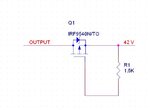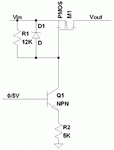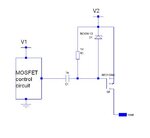Dinuwilson
Advanced Member level 4
 i am using IRF9540 p channel mosfet for my solar charger.when i connect gate to groung mosfet is on. my problem is i can't turn off the mosfet
i am using IRF9540 p channel mosfet for my solar charger.when i connect gate to groung mosfet is on. my problem is i can't turn off the mosfet my input voltage is 42v. in this case if i connect 42 v in mosfet it alway's on . i can't connect gate directly through mosfet input (through resistor) because IRFz9540 gate voltage is +20v. in this case how i can control mosfet.

